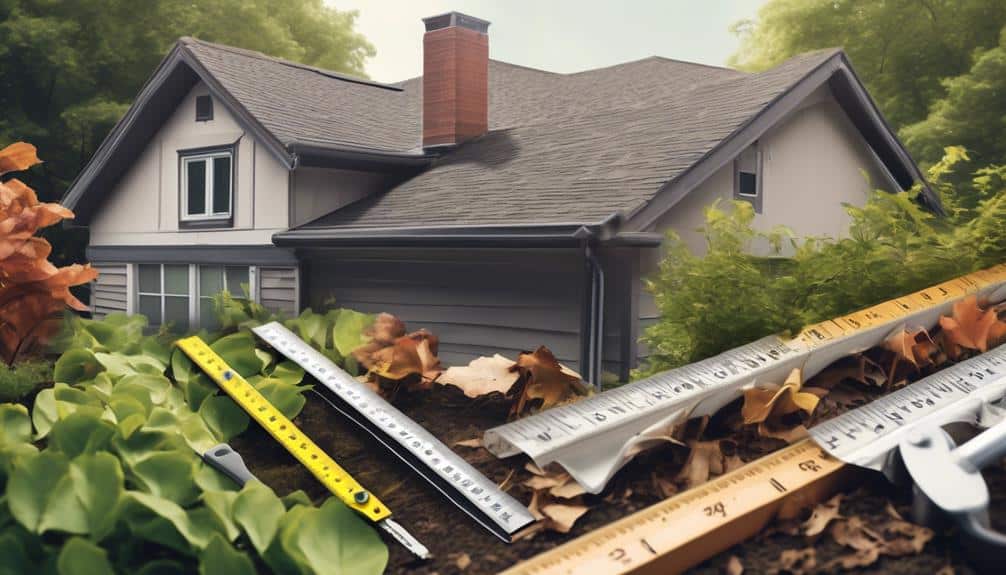Choosing the right gutter size is crucial for effective drainage and home protection. Measure your roof’s total square footage and adjust for pitch. Consider the maximum rainfall intensity in your area. Select a gutter type, such as K-Style or Half-Round, that matches your home’s architecture and handles the rainwater volume. Ensure downspouts are proportionate and well-placed. Fine-tune calculations and understand material choices based on specific requirements like roof dimensions and local weather conditions.
Key Takeaways
To choose the right gutter size:
- Measure the roof’s total square footage.
- Select a gutter type (K-Style, Half-Round) that matches your home’s design.
- Adjust calculations for the roof pitch.
- Consider local maximum rainfall intensity.
- Ensure gutters handle the calculated rainfall volume for proper drainage.
How to Choose the Right Gutter Size?
To choose the right gutter size, start by measuring the total square footage of your roof. This determines the capacity requirements for your gutters to handle rainfall volume and prevent overflow.
Next, select the type of gutter: K-Style or Half-Round. K Style gutters, popular for their modern look and higher capacity, are suitable for larger roofs.
They come in 5-inch and 6-inch sizes, with the 6-inch variant offering better water management. Half-Round gutters, common in older homes, provide aesthetic appeal but have lower capacity, typically available in similar sizes with the 6-inch being more effective.
Consider the pitch of your roof. A steeper roof channels water faster, requiring larger gutters. Also, a factor is the maximum rainfall intensity in your area. It can be found in local weather data. Higher rainfall necessitates larger gutters for efficient drainage.
How Do You Measure the Dimensions Needed for Roof Area Calculation?
To measure the dimensions needed for roof area calculation, use a tape measure to record the length and width of each roof section.
First, from a safe vantage point, measure the length by extending the tape measure along the longest edge of each section. Record this measurement. Next, measure the width by extending the tape measure from the eave to the ridge. Note this dimension. Repeat for each roof section.
Multiply the length and width for each section to calculate the area (Length x Width). For example, if one section measures 30 feet in length and 20 feet in width, the area is 600 square feet. Sum the areas of all sections to get the total roof area.
Measure the roof pitch using a level and a tape measure to determine the rise over a 12-inch run. This helps apply the necessary pitch multiplier to adjust the total roof area for accurate calculations.
What Are the Different Standard Gutter Types Available?

The different standard gutter types available are K-Style and Half-Round.
K-Style gutters are prevalent in residential areas. They have a flat back and a decorative front resembling crown moulding, making them suitable for both modern and traditional home designs. Their shape maximizes water capacity, and they come in 5-inch and 6-inch widths. Common materials include aluminium, vinyl, and steel.
Half-Round gutters are chosen for their aesthetic appeal, especially in historic or older homes. Their semicircular shape ensures smooth water flow with fewer obstructions.
They also come in 5-inch and 6-inch sizes, with copper, aluminium, and galvanized steel as common materials.
Less common types include Box gutters, typically used in commercial or industrial settings due to their large capacity and concealed installation. S
electing the appropriate gutter type depends on the architectural style and water management requirements of the home.
How Can You Determine if the Downspouts Are Right Sized to Match the Gutter Capacity?
To determine if downspouts are appropriately sized to match the gutter capacity, evaluate the volume of water the gutter system is designed to handle and select downspouts that can efficiently channel that volume away from the roof.
Downspouts must manage the maximum water flow that gutters collect during peak rainfall events, ensuring water is diverted away from the structure to prevent damage.
Start by understanding the capacity of your gutters. For example, standard 5-inch K-style gutters typically require 2×3 inch downspouts, while 6-inch K-style gutters often necessitate 3×4 inch downspouts. This ensures the downspout can handle the water volume without causing backups or overflow.
Half-round gutters, which are less efficient, may need larger downspouts to accommodate the same water volume. Consider the spacing and number of downspouts.
Generally, one downspout is recommended for every 20 to 30 linear feet of gutter. This distribution helps manage water flow efficiently, preventing overloading any single downspout and avoiding water damage or erosion around the foundation.
Also, factor in the specific rainfall intensity of your area. In regions with heavier rainfall, larger downspouts or increased numbers may be necessary to cope with the higher water volume.
Consulting local rainfall data can provide insights into the expected maximum intensity, guiding the appropriate sizing of downspouts.
How Do You Calculate Gutter Size for Rainfall Intensity?

To calculate the gutter size for rainfall intensity, first determine the maximum rainfall rate for your area, usually in inches per hour, available from local weather stations or historical records.
Next, measure the roof’s surface area that directs rainwater into the gutters. Measure the length and width of each roof section and sum these to get the total square footage.
Adjust for roof pitch by using a multiplier, such as 1.2 for a steeper roof. The constant 0.623 converts volume from cubic inches per hour to gallons per minute.
Compare the calculated capacity with standard gutter sizes. For example, 5-inch K-style gutters handle about 5.5 gallons per minute per foot, and 6-inch gutters handle about 7.5 gallons per minute per foot. Ensure your chosen gutter can manage the runoff to prevent overflow.
What Factors Determine the Cost of Gutter Installation in Ireland?
The average gutter installation cost in Ireland is influenced by several factors. The size of the house, type of gutters, labour expenses, and any additional components like downspouts or guards all play a role in determining the overall cost. The location and accessibility of the property also impact the final price.






